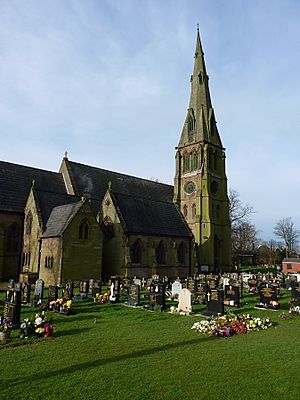Erdington Abbey facts for kids
Quick facts for kids Erdington Abbey |
|
|---|---|
| Church of St Thomas and St Edmund | |

Erdington Abbey
|
|
| Location | Birmingham |
| Country | England |
| Denomination | Roman Catholic |
| History | |
| Dedication | Thomas of Canterbury and Edmund of Canterbury |
| Architecture | |
| Heritage designation | Grade II listed |
| Architect(s) | Charles Hansom |
| Groundbreaking | 1848 |
| Completed | 1850 |
| Administration | |
| Archdiocese | Birmingham |
Erdington Abbey Church, also known as the Church of Saints Thomas and Edmund, is a historic Roman Catholic church in Erdington, Birmingham, England. It is a special building because it is Grade II listed, meaning it is protected for its historical importance. The church is part of the Archdiocese of Birmingham and is looked after by a group of priests called the Redemptorists. The building next to the church, which used to be the actual abbey, is now a school called Highclare School.
Contents
Building the Erdington Abbey Church
In 1847, a priest named Father Heneage built a small chapel in Erdington. Before this, Catholic services were held in a house. The main church building was started by Reverend Daniel Henry Haigh. He laid the first stone on May 26, 1848.
The church officially opened on June 11, 1850. It was designed by an architect named Charles Francis Hansom. He made the church in the Gothic Revival style, which means it looks like old medieval churches. The tall steeple of the church is 117 feet (about 35.6 meters) high, which is also the length of the whole building! Some of the beautiful metalwork inside the church was designed by Augustus Pugin.
The Abbey Building and Benedictine Monks
In 1876, Father Haigh gave the church and its land to a group of Benedictine monks. These monks came from Beuron Abbey in Germany. They had to leave their home country because of a difficult time called the "Kulturkampf". This was a period when the German government, led by Otto von Bismarck, made laws against the Catholic Church.
The monks built their abbey next to the church. This abbey building is also a protected Grade II listed building.
The Redemptorist Priests Take Over
The Benedictine monks faced more challenges during World War I (1914–1918). Because most of them were German, it became very hard for them to stay in England. After the war ended in 1918, they were able to go back to Germany, and Erdington Abbey was no longer a monastery.
In 1922, the Redemptorist order of priests took over the church and parish. They have been serving the community there ever since. Today, the church is led by Father Elias Gweme CSsR, who is the Rector and Parish Priest. He works with Father Francis Dickinson CSsR, Father Isaac Davies CSsR, and Father Royston Price CSsR.
The Cemetery
Next to the church is a cemetery. This cemetery has special graves for soldiers who died in the World Wars. There are graves for three soldiers from World War I and six people (two soldiers and four Royal Air Force personnel) from World War II. These graves are looked after by the Commonwealth War Graves Commission.

